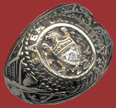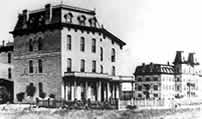|
|
|

The Agricultural and Mechanical College of
Texas
On Monday, October 2, 1876, the Agricultural
and Mechanical College of Texas, the first state-supported institution
of higher learning, was officially opened for registration. The
opening resulted from the Morrill Act passed by Congress fourteen
years earlier, which provided a permanent fund to be raised through
the sale of public land given to the states. The accruing interest
from this fund was to be used to support a technical college which,
among other things, specialized in the studies of mechanics, agriculture,
and military tactics. Monday, October 2, 1876 was the first official
day of classes at A&M. Unfortunately, only a handful of students
appeared on that appointed matriculation day. On Wednesday, October
4, 1876, forty students and six faculty members began instruction,
with Thomas Gathright as acting president. Governor Richard Coke
was present on this day to dedicate the school and wish it success;
and his advice is still included as required knowledge for Cadets.
A Hard Battle for Survival
In the first few years after its opening, the College
fought a hard battle for survival. A turning point came when Lawrence
Sullivan Ross, then Governor of Texas, accepted the appointment
as president in 1890. Sul Ross, loved and respected by Texans for
his actions as a soldier, statesman, and gentleman, led A&M
from a state of near failure to a secure position as a successful
and growing institution. He is fondly remembered for his institution
of discipline, organization, and honor into the Corps of Cadets.
"Sully" strongly supported competitive sports as a unifying
activity that built character, physical courage and fitness. Texas
A&M fielded its first football team in 1893, but not until the
next year did it play any road games, including the first in the
long and memorable series with Texas University. At this time the
important buildings were Gathright Hall and the Main Building (in
which classes were held). In 1900 there were 327 Cadets in the Corps.
The Creation of a Dauntless
Spirit
Once firmly established, Texas A&M continued
to grow until by 1912 the enrollment stood at 1200. It was during
this year that disaster struck with the burning of the old mess
hall, followed in a few months by a terrible fire which razed the
Main Building, destroying most of the early records of the College.
Sbisa Hall and the Academic Building rose in their place, symbolizing
the dauntless spirit of the institution to continue despite its
setbacks. Texas Aggies have always been known for their fighting
spirit.
A Distinguishing Element of
the Corps Character
From the first days of A&M's history, the military
tradition has been deeply ingrained in this school as a distinguishing
element of its character. Ever since the Spanish-American War of
1898 Aggies have served with honor in virtually every conflict in
which the United States has been involved. Eight Aggies have been
awarded the United States’ highest military award, the Medal
of Honor. Over 225 Aggies have become Generals and Admirals. Today,
around the world, the men and women of A&M continue their exemplary
service in defense of our great nation.
Answering the Call to Arms
In April 1917, America was drawn into the conflict
raging in Europe that came to be known as World War I. In typical
Aggie fashion, Cadets answered the call to arms. The senior class
of 1917 volunteered in a body for officer's training at Leon Springs,
near San Antonio, a month before the end of school. Recognizing
the patriotic motive of this action, the College awarded them their
degrees. Training could not be interrupted for academic ceremonies
on the campus, and that year the graduation exercises for Texas
A&M were held under a large oak tree in the hills near San Antonio.
Fifty-five Aggies gave their lives in this war and many more were
wounded in the service of their country.
Steady Expansion
The College steadily expanded between the two World
Wars of the 20th Century. By 1941, the enrollment stood at 6,500.
The physical plant had developed from the original two buildings
and 2,416 acres to over seventy major buildings with a total value
of approximately 15 million dollars.
Quick to Respond
On December 7, 1941, America was plunged into World
War II, and Aggies were again quick to respond to the nation's call
to arms. In order to speed up its contribution of well-trained men,
the college instituted a twelve-month, three-semester program of
study. In addition, the College offered training to Army Specialized
Training Program (ASTP) Cadets, Army Air Corps, Navy radio specialists,
and Marine Corps trainees. Some 5,000 reserve officers who had been
trained and commissioned at A&M, and another 7,000 who had received
some military training here, were commissioned through Officers
Candidate Schools answering the call to arms during World War II.
Six thousand more served effectively as the direct result of A&M
training, most of them noncommissioned officers. The service of
these 18,000 Aggies did much to enhance the brilliant record of
Texas A&M as well as to uphold the tradition of "the fightin'
Texas Aggies".
General Douglas MacArthur
During the early stages of World War II General Douglas
MacArthur wrote:
"...Texas A&M is writing
its own military history in the blood of its graduates... No name
stands out more brilliantly than the heroic defender of Corregidor,
General George F. Moore. Whenever I see a Texas man in my command,
I have a feeling of confidence..."
Enrollment Skyrockets
With the end of the war and a return to a regular
nine-month academic program, the enrollment of A&M skyrocketed.
Returning veterans, aided by the G.I. Bill of Rights, brought the
enrollment of the college to a peak in its history of 9,000 students
in the 1946-47 school year. For a few years the College even maintained
an annex at an inactive Air Force base near Bryan (now known as
the Riverside Campus). Despite overcrowded conditions, the expansion
and development of its education facilities continued.
General Omar Bradley
General Omar Bradley told the June 1950 graduating class:
"...At Texas A&M there has
been an almost unlimited opportunity for you in science, in agriculture,
and veterinary medicine, in engineering and arts. In true Texas
tradition, you have been provided with outstanding training in military
science, in aeronautical science, and in physical education. The
men of Texas A&M can stand up to any men in the world and compare
favorably their education and training for leadership - leadership
in the pursuits of peace, and, if it comes to war, leadership in
battle. This combination is significant, for the capability for
a productive peace, coupled with the ability to defend your beliefs,
as well as your resources, is essential to survival..."
From College to University
Because of the great expansion in number and diversity
of academic subjects the name of the College was changed to Texas
A&M University on August 23, 1963. In the fall of 1964, women
were admitted to A&M and, in 1965, membership into the Corps
of Cadets became voluntary for male students. Women were first admitted
into the Corps of Cadets in 1974. At first they were assigned to
their own units under male leadership which they progressively replaced.
The first truly integrated unit was the Aggie Band in 1985 and Squadron
15 was the first non-band outfit to be truly integrated in 1989.
In 1971, Texas A&M University became only one of four institutions
in the country to be designated a Sea Grant College, and in 1989
it was granted Space Grant status.
Distinguished Military Service
Seven sons of Texas A&M have won the nation's
highest military honor, the Medal of Honor. More than 225 former
students of Texas A&M have reached General or Flag Officer rank.
Among these was the late General George F. Moore, ’08, one-time
Commandant of Cadets, whose brilliant service in the defense of
Corregidor is one of the brightest pages of military history. Today,
the outstanding unit of the Corps of Cadets carries the General
George F. Moore flag.
|



